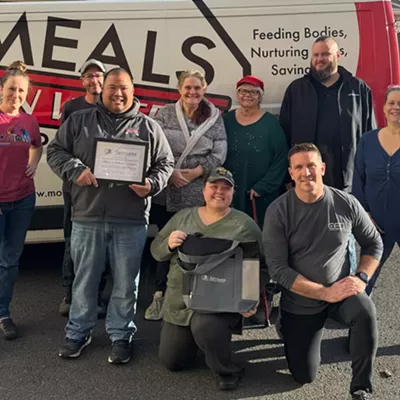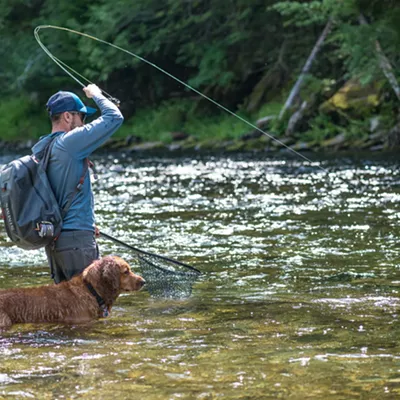As spring rains turn to warm days, wildflowers start to blossom throughout the Inland Northwest, and where there are wildflowers, you'll often find birds, butterflies and a wealth of wildlife. One of the best ways to get out and experience all that beauty is to lace up your hiking boots and take to one of the many beautiful regional trails.
But, lack of planning and the proper gear can turn an anticipated adventure into a dreary slog. So read on for tips on where to go, how to find fellow hikers, and what gear you'll need to bring to thoroughly enjoy your trek.
Get Out the Map
The first decision is where to go. Luckily, there are multiple new hikes as well as new connections to popular hiking systems that have been finished in the last year or so, and outdoor advocates are eager to see people take to those paths.
The Trentwood Trailhead, for example, was completed in late 2021, and offers an addition to the Antoine Peak Conservation Area by granting access where Wellesley Avenue meets Flora Road in Spokane Valley.
"We've been working on trails behind the scenes before the trailhead was even finished, so there's a complete system that ties in," says Holly Weiler, the Eastern Washington regional coordinator with Washington Trails Association.
While that system can get muddy on a rainy day, it should be fairly dry by late spring because of its low elevation and location, Weiler says. It is accessible year-round.
"By April there should be tons of flowers blooming," Weiler says.
Another place that Weiler likes in the spring is the Sherman Creek Wildlife Area in the Kettle Range. Plan for a full day trip if you're leaving from Spokane, as the drive is about two hours to get from downtown to the trailhead.
"You can actually get down to the shoreline along Lake Roosevelt in a couple of areas, so it's almost a beach hike in some areas," Weiler says. "It's a really pretty spring hike."
Washington Trails Association's website at wta.org is a treasure trove of specific information on those and other hikes. Not only will you find maps and driving directions, but you may also find recent photos or trip reports from other hikers.
The Dishman Hills Conservancy has also been hard at work on their brand new Wilson Nature Trail to give access to the Wilson Conservation Area. The land trust bought that land in 2019, and it is located near the Stevens Creek Trailhead, south of the Rocks of Sharon.
Plus, there are plenty of other trail projects in the works.
"It's fantastic right now — there are lots of great new things with county parks," Weiler says. "When we get later in the season, we'll have new things happening with Mount Spokane State Park, and much later we'll have some projects with the Colville National Forest."
Walk with Me
Sometimes finding others eager to go for a hike is more challenging than the hike itself. One way to find folks with similar interests is to actually lend a hand with trail building with the Washington Trails Association. Sign up at wta.org/volunteer.
"I put a tool in people's hands first, and take people hiking," Weiler says of the volunteer trips. "It's very rewarding to know that what you're doing, people will be enjoying for years to come."
Not ready for quite that much effort?
Local conservation groups such as the Dishman Hills Conservancy often lead educational hikes throughout the region. The Spokane Mountaineers, a membership organization with an annual fee, also leads a huge variety of group activities, including hikes, biking, camping trips, paddling, climbing, skiing and more.
Plus, there are multiple hiking Meetup groups in the area, including Inland Northwest Hikers, where you can sign up to join a group of like-minded people in the great outdoors.
Remember, before you get out on the trail, it's key that you pack your 10 essentials, including water, food and clothing layers, even if you think you'll only be out for a short trek.
Gear
One of the best pieces of advice that outdoor shop owner Mark Schneider gives to people is to "buy once, cry once." By that, he means it's well worth investing in high-quality, name-brand gear that may be more expensive upfront, rather than falling for the allure of a cheap knockoff. When you opt for the cheaper brands, you may end up spending even more money as your gear wears out faster and doesn't work as well.
"A lot of times [cheap brands] skimp on the quality of materials and manufacturing in order to undercut the retailers that have led the way, which can lead to gear and clothing that wears out faster or fails in the field," Schneider says.
Anecdotally, he's heard of supposedly "waterproof" shoes that left hikers with drenched feet, and in other cases soles on cheaper boots have even fallen off while out in nature.
At his store, Rambleraven Gear Trader, you can find that high-quality brand new gear, and if you're lucky enough to find your size, you might even cry a little less at the cost of used hiking boots or other outdoor equipment, as they only consign top-quality brands.
Aside from the 10 essentials, Schneider recommends doing some research on the trail or area you'll be spending time in so you know what to be prepared for, whether that's potential wildlife encounters or different terrain.
Wearing wicking clothing is highly recommended over cotton, which can leave you wet and chilled if you sweat in it while walking, hiking or climbing and then inevitably cool down. Wicking layers, which are often made from synthetic materials, help pull that moisture away from your body and keep you at a safer temperature.
Even if it looks like a beautiful, sunny day is in store, it's important to bring layers and other necessities in case the unexpected happens, he says.
"Making sure you pack your daypack for the worst potential situation is very important," Schneider says. "It's very easy to be misled by a blue sky weather forecast only to get up on top of a mountain or a rise and a freak hailstorm will come through or a gust of wind, and now you find yourself in a hypothermic situation in the middle of summer."
Or, say you get injured and it takes you many more hours to return to the trailhead than you expected. Even in warmer months, temperatures can have huge variation, dropping by 40 or 50 degrees by nightfall, and similarly putting you at risk of hypothermia, Schneider says.

Being aware of trail conditions is also important. In spring and early summer, some trails may be muddy after heavy rain, in which case Schneider says it's best to turn back rather than venturing off the beaten path and unnecessarily widening trails that work crews will have a hard time fixing later.
It's also a good idea to do some research to be aware of wildlife and vegetation in the area you're headed to, he says. That will help you know if you need to pack bear spray or keep an eye out for rattlesnakes.
Checking your scalp and body for ticks when you get home is also a good idea, even though tick-caused lyme disease cases are relatively rare in Washington (an estimated zero to seven cases are acquired in the state each year). The Washington State Department of Health reports the ticks that cause the disease are mostly found in Western Washington, and other experts say those ticks don't live in Idaho. One way to avoid ticks and other bug bites is to wear long, lightweight layers to keep most of your skin covered throughout your time outside.
For the latest tips on sightings of animals on trails, closures, upcoming projects and more, you can check out the social media pages of outdoors organizations such as Washington Trails Association, Inland Northwest Land Conservancy, The Lands Council and more, Schneider says.
"All of our local nonprofits have a social media presence where they discuss trail specific issues, concerns and developments," he says. "They are all great resources for what is happening locally."
Ten Essentials
Whenever you head into the wilderness, bringing the 10 essentials can help you with unforeseen mishaps, and if things go wrong enough, they could even save your life. The items most experts agree you should always take with you include:
Navigation • A map and compass, GPS is helpful but don't count on cell service to navigate
First aid kiT • A small kit that includes bandaids, fabric bandages in case of a rolled ankle, pain medication, and ointment for stings and cuts
Fire • A lighter or matches in case you need to start a fire
Food • Bring more food/snacks than you think you'll need
Water • Adults need about 16 to 32 ounces of water per hour of hiking
Light • A flashlight or headlamp in case you get lost or delayed
Knife/tools • Consider gear that may need repairs if something goes wrong
Sun protection • Sunglasses, a hat/head covering, sunscreen
Extra clothes/layers • It's better to have it and not need it than to need it and not have it.
Emergency shelter • Emergency space blanket, tarp or small tent






















